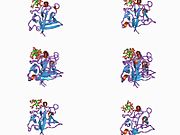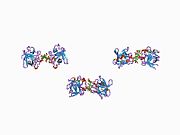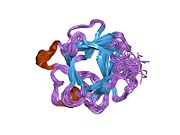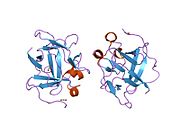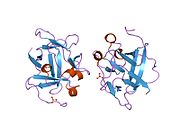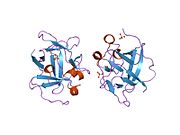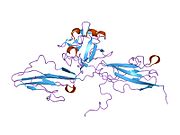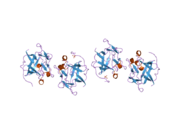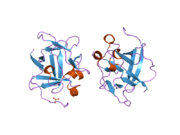FGF1
| View/Edit Human | View/Edit Mouse |
Fibroblast growth factor 1, (FGF-1) also known as acidic fibroblast growth factor (aFGF), is a
FGF-1 has no definitive signal sequence and thus is not secreted through classical pathways, but it does appear to form a disulfide linked dimer inside cells that associate with a complex of proteins at the cell membrane (including
In addition to its extracellular activity, FGF1 can also function intracellularly. The protein has a
Function
FGF family members possess broad
FGF1 is multifunctional with many reported effects. For one example, in mice with diet-induced diabetes that is an experimental equivalent of type 2 diabetes in humans, a single injection of the FGF1 protein is enough to restore blood sugar levels to a healthy range for > 2 days.[12]
Interactions
FGF1 has been shown to
See also
References
- ^ a b c GRCh38: Ensembl release 89: ENSG00000113578 – Ensembl, May 2017
- ^ a b c GRCm38: Ensembl release 89: ENSMUSG00000036585 – Ensembl, May 2017
- ^ "Human PubMed Reference:". National Center for Biotechnology Information, U.S. National Library of Medicine.
- ^ "Mouse PubMed Reference:". National Center for Biotechnology Information, U.S. National Library of Medicine.
- PMID 1697263.
- PMID 3523756.
- PMID 2549857.
- PMID 7493920.
- ^ PMID 12135982.
- ^ PMID 24780002.
- ^ "Entrez Gene: FGF1 fibroblast growth factor 1 (acidic)".
- PMID 25043058.*Lay summary in: "One injection stops diabetes in its tracks". Salk Institute. July 16, 2014.
- ^ PMID 12145206.
- PMID 9806903.
- PMID 11030354.
- ^ PMID 8576175.
- PMID 10618369.
- S2CID 4418272.
- PMID 10574949.
- PMID 10736564.
- PMID 10336501.
- PMID 10510314.
- ^ PMID 9712836.
- PMID 11432880.
Further reading
- Yu YL, Kha H, Golden JA, Migchielsen AA, Goetzl EJ, Turck CW (April 1992). "An acidic fibroblast growth factor protein generated by alternate splicing acts like an antagonist". The Journal of Experimental Medicine. 175 (4): 1073–80. PMID 1372643.
- Chiu IM, Wang WP, Lehtoma K (May 1990). "Alternative splicing generates two forms of mRNA coding for human heparin-binding growth factor 1". Oncogene. 5 (5): 755–62. PMID 1693186.
- Zhu X, Komiya H, Chirino A, Faham S, Fox GM, Arakawa T, Hsu BT, Rees DC (January 1991). "Three-dimensional structures of acidic and basic fibroblast growth factors". Science. 251 (4989): 90–3. PMID 1702556.
- Wang WP, Quick D, Balcerzak SP, Needleman SW, Chiu IM (September 1991). "Cloning and sequence analysis of the human acidic fibroblast growth factor gene and its preservation in leukemia patients". Oncogene. 6 (9): 1521–9. PMID 1717925.
- Wu DQ, Kan MK, Sato GH, Okamoto T, Sato JD (September 1991). "Characterization and molecular cloning of a putative binding protein for heparin-binding growth factors". The Journal of Biological Chemistry. 266 (25): 16778–85. PMID 1885605.
- Crumley G, Dionne CA, Jaye M (August 1990). "The gene for human acidic fibroblast growth factor encodes two upstream exons alternatively spliced to the first coding exon". Biochemical and Biophysical Research Communications. 171 (1): 7–13. PMID 2393407.
- Harper JW, Strydom DJ, Lobb RR (July 1986). "Human class 1 heparin-binding growth factor: structure and homology to bovine acidic brain fibroblast growth factor". Biochemistry. 25 (14): 4097–103. PMID 2427112.
- Winkles JA, Friesel R, Burgess WH, Howk R, Mehlman T, Weinstein R, Maciag T (October 1987). "Human vascular smooth muscle cells both express and respond to heparin-binding growth factor I (endothelial cell growth factor)". Proceedings of the National Academy of Sciences of the United States of America. 84 (20): 7124–8. PMID 2444975.
- Wang WP, Lehtoma K, Varban ML, Krishnan I, Chiu IM (June 1989). "Cloning of the gene coding for human class 1 heparin-binding growth factor and its expression in fetal tissues". Molecular and Cellular Biology. 9 (6): 2387–95. PMID 2474753.
- Mergia A, Tischer E, Graves D, Tumolo A, Miller J, Gospodarowicz D, Abraham JA, Shipley GD, Fiddes JC (November 1989). "Structural analysis of the gene for human acidic fibroblast growth factor". Biochemical and Biophysical Research Communications. 164 (3): 1121–9. PMID 2590193.
- Gimenez-Gallego G, Conn G, Hatcher VB, Thomas KA (July 1986). "The complete amino acid sequence of human brain-derived acidic fibroblast growth factor". Biochemical and Biophysical Research Communications. 138 (2): 611–7. PMID 3527167.
- Gautschi P, Fràter-Schröder M, Böhlen P (August 1986). "Partial molecular characterization of endothelial cell mitogens from human brain: acidic and basic fibroblast growth factors". FEBS Letters. 204 (2): 203–7. S2CID 22617694.
- Gautschi-Sova P, Müller T, Böhlen P (November 1986). "Amino acid sequence of human acidic fibroblast growth factor". Biochemical and Biophysical Research Communications. 140 (3): 874–80. PMID 3778488.
- Gimenez-Gallego G, Conn G, Hatcher VB, Thomas KA (March 1986). "Human brain-derived acidic and basic fibroblast growth factors: amino terminal sequences and specific mitogenic activities". Biochemical and Biophysical Research Communications. 135 (2): 541–8. PMID 3964259.
- Zhao XM, Yeoh TK, Hiebert M, Frist WH, Miller GG (November 1993). "The expression of acidic fibroblast growth factor (heparin-binding growth factor-1) and cytokine genes in human cardiac allografts and T cells". Transplantation. 56 (5): 1177–82. PMID 7504343.
- Pineda-Lucena A, Jiménez MA, Nieto JL, Santoro J, Rico M, Giménez-Gallego G (September 1994). "1H-NMR assignment and solution structure of human acidic fibroblast growth factor activated by inositol hexasulfate". Journal of Molecular Biology. 242 (1): 81–98. PMID 7521397.
- Chotani MA, Payson RA, Winkles JA, Chiu IM (February 1995). "Human fibroblast growth factor 1 gene expression in vascular smooth muscle cells is modulated via an alternate promoter in response to serum and phorbol ester". Nucleic Acids Research. 23 (3): 434–41. PMID 7533902.
- Opalenik SR, Shin JT, Wehby JN, Mahesh VK, Thompson JA (July 1995). "The HIV-1 TAT protein induces the expression and extracellular appearance of acidic fibroblast growth factor". The Journal of Biological Chemistry. 270 (29): 17457–67. PMID 7542239.
- Myers RL, Payson RA, Chotani MA, Deaven LL, Chiu IM (February 1993). "Gene structure and differential expression of acidic fibroblast growth factor mRNA: identification and distribution of four different transcripts". Oncogene. 8 (2): 341–9. PMID 7678925.

